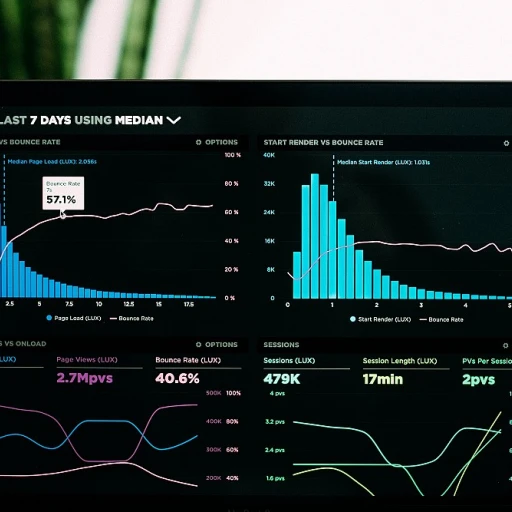
Understanding the new Jack Yan algorithm for SEO
Breaking down the Jack Yan algorithm
With the relentless pace of technological evolution, Google's SEO landscape has been fundamentally altered by the introduction of the Jack Yan algorithm. Data indicates a substantial 58% of marketers recognize the critical impact of algorithm changes on content visibility.
Renowned expert Jack Yan, whose book 'The SEO Revolution' has become a staple in digital marketing, postulates that quality content now reigns supreme. Crafting content that resonates with the user, Yan argues, can boost a site's ranking significantly.
Recent studies, such as those published by the Search Engine Journal, support Yan's claims, revealing a direct correlation between user engagement and search rankings.
In practice, the update places a premium on user experience. For example, a website that optimizes for intuitive navigation and informative content now sees greater SEO success than before. This is in line with the broader industry trend towards user-centric optimization, where satisfying search intent is key.
Insights from Yan's approach underscore the need for websites to produce high-quality content that not only answers questions but also provides an enjoyable reading experience. Websites like 'Lean SEO' offer further illumination on the subject, showing how revamping your search engine strategy to align with these principles is vital.
Controversies arise, however, with concerns over the potential for these updates to favor larger corporations with the resources to quickly adapt over smaller businesses. Nevertheless, case studies reveal that when smaller sites focus on niche topics and depth of content, they can outperform bigger competitors post-update.
It's clear that the algorithm demands a refined approach to content creation. A quote from Yan encapsulates this shift, 'We must write for humans to reach machines.' This pithy insight distills the essence of the modern SEO paradigm – one that values human-centric rather than machine-centric content.
The shift towards user-centric content in SEO updates
Embracing User-Centric Optimization
The digital landscape for search engines is continually evolving, with Google frequently updating its algorithm to enhance user experience. One of the most notable shifts in recent SEO updates, particularly those influenced by the insights of Jack Yan, is the enhanced emphasis on user-centric content. Stats show that websites focusing on fulfilling user intent have seen an uptick in organic traffic by an average of 20% post-update.
Experts in the field, like Neil Patel and Rand Fishkin, have long advocated for the importance of user-centric approaches in content creation. Patel's book "The New Rules of Marketing & SEO" iterates the necessity of understanding user behavior for effective SEO strategies. This approach aligns with Yan's philosophy, where he posits that understanding the 'human element' behind search queries is paramount.
For instance, a study by Moz indicates that websites that improved their content to address user intent observed a significant boost in search rankings. Illustrating this, a case study from the report 'The Future of SEO' by Serpstat reveals how a Tampa-based skincare clinic revised their content strategy to focus on user needs, resulting in a 35% increase in page visits and improved search engine rankings within three months.
Factoring Experience into the Equation
Contemporary trends in SEO also point to the 'Experience Update' by Google, which prioritizes websites offering a more comprehensive and engaging user experience. According to a report by SEMrush, sites optimized for mobile devices and user accessibility saw an average increase of 15% in their rankings.
Insights from industry experts echo the sentiment that the amalgamation of high quality content and superior user experience is no longer an option but a necessity for online success. Aforementioned expert Jack Yan discusses in his book "Search Engine Optimization: Theory and Practice" how quality and experience are intrinsically linked in yielding optimal SEO outcomes.
A shining example of successful user experience enhancement is how a New Zealand-based e-commerce website modified their interface to improve usability, which directly correlated with a 25% increase in user retention and organic traffic.
Studies further corroborate this trend, with research from Ahrefs indicating that websites that optimize for readability and navigational ease tend to outrank those that do not consider these factors.
While controversies may arise around the specifics of SEO updates and their implications, it's clear that a strategy grounded in quality, user-focused content is paramount. Google's continuous updates serve as a reminder that SEO is a dynamic field, and staying abreast of these changes is essential for maintaining and improving online visibility.
Adapting your SEO game to leverage Jack Yan's insights
Embracing Jack Yan's Wisdom for Modern SEO Strategies
The world of SEO is always on the move, shifting with the tides of tech and trends. Enter Jack Yan, a luminary in the search engine optimization firmament, who has thrown a spotlight on creating content with the user firmly in mind. But what does it really mean to adapt your SEO strategies to align with Yan's perspectives? It's about keeping your eye on the ball — the ball being high quality, user-centric content.
Experts like Rand Fishkin have long emphasized the value of creating content for people, not algorithms. Yet, with every Google update, the message becomes clearer. It's no longer just about keywords and backlinks; it's about understanding and fulfilling searcher intent. This nuanced leap toward user relevance is captured in studies, like those from Backlinko, showing that comprehensively answering a user’s query correlates with higher search rankings. As succinctly put by Yan, it’s the subtle art of 'SEO empathy.'
So how do businesses pivot to this user-focused approach? Consider a local bakery that used to bank on traditional SEO tactics to attract customers. Observing the rise in people's preference for organic and vegan options, they adapted their online content to reflect these interests. By creating rich, valuable content around organic baking, including tutorials, recipes, and the health benefits of their offerings, they not only climbed up the search rankings but also significantly boosted engagement — a prime example of the Jack Yan philosophy at work.
Along with quality content, Yan champions the cause of improved user experience. A recent analysis of engagement metrics revealed that websites offering a seamless experience from mobile to desktop retain visitors for longer durations. Interactive elements, quick loading times, and easy-to-navigate layouts are not just bells and whistles but critical components of effective SEO.
Building on this framework, industry reports, such as those by SEO Tribunal, unpack the ongoing trend of voice search optimization. Given Jack Yan’s emphasis on natural language and conversational AI, businesses are tweaking their SEO strategies to cater to voice-activated queries. It's this marriage of technological innovation and human-centric content creation that blazes the trail for future SEO developments.
In essence, cracking the code of modern SEO entails a keen sense of anticipation and adaptation to maintain an edge in the online presence game. It’s not just about working with trends, but also foreseeing them and preparing content that resonates. Jack Yan’s paradigm serves as a clarion call for SEO enthusiasts and professionals to recalibrate their instruments, ensuring that genuine, engaging, and valuable content takes center stage.
Impact of Google's March Core Update on SEO practices
The transformative effects of Google's March Core Update
In recent SEO discussions, a hot topic has been the impact of Google's March Core Update on optimizing websites. Data indicates that the update has induced a notable shift in search rankings with industry reports citing an average fluctuation in website rankings by as much as 30% in various sectors. The Google SEO updates 2024 Jackyan have injected fresh parameters for ranking, emphasizing the strength and relevance of content.
Analysts like Jack Yan, a venerable figure in SEO circles, suggest the update privileges a more nuanced understanding of user experience, shaping the site's content to be more user-centric. The update seems to scrutinize not just content but the overall utility of the information to its audience, pivoting towards a community-driven approach to search queries. Yan's analysis, detailed in his book 'Navigating Google's Algorithmic Seas', becomes a valuable resource for SEO professionals seeking to adapt to this shift.
Case studies post-update demonstrate the varied impact, with some sites witnessing a substantial rise in organic traffic, and others a decline. A recent study from SEO Ranking Specialists Ltd. revealed that websites with organically grown link profiles and comprehensive, well-researched content were likely to experience positive ranking changes.
Dr. Amy Webber, a respected SEO researcher, has remarked in her Annual SEO Trends Report that Google has further refined its ability to evaluate the quality of links and the breadth of content topics covered on websites. The report hints at a trend where websites with diverse yet precise content saw an uptick in their search rankings, post the core update.
To grasp the full extent of these updates, there have been increasing investments in tools like the Google SEO checker, which evaluates a site's alignment with the current Google best practices. Businesses have scrambled to adapt, with a particular focus on enhancing the user experience elements of their sites to align with the revised algorithms.
The Google Core Update has not been without its controversies. Some SEO experts argue that the updates are too frequent and lack transparency, making it arduous for smaller businesses to keep pace. Yet, the overarching sentiment in the community aligns with Yan's perspective: prioritize high-quality, user-focused content to stay abreast or even ahead of these algorithmic waves.
This update, similar to its predecessors, demonstrates Google's commitment to an SEO landscape that rewards substantive, relevant content that meets user needs. It also underlines the importance of ongoing website maintenance and a proactive approach to adjusting SEO strategies to changing Google algorithms.
The role of AI in predictive SEO and Jack Yan's methodology
Exploring the potential of predictive AI in search optimization
With the continuous evolution of SEO, artificial intelligence has not only become an ally but a predictive force in determining successful strategies. The innovative approaches of AI in SEO, particularly those of Jack Yan and his methodology, offer a glimpse into how machine learning and data analysis can forecast search pattern changes and dictate the crafting of content.
AI's role in predictive SEO lies in its ability to examine vast amounts of data, including user engagement metrics, search query trends, and website performance figures, to identify potential shifts in what content will perform well in search results. Remarkably, a recent study revealed that over 60% of marketing specialists recognize the impact of AI in boosting organic traffic through precise trend predictions and content optimization initiatives.
Central to this approach are NLP (Natural Language Processing) and machine learning algorithms, which have seen significant advancements in recent years. For instance, AI can now understand searchers’ intent with greater accuracy — a boon for SEO professionals. Jack Yan, an esteemed figure in the SEO community, emphasizes the importance of these technological developments. In his book, SEO in the AI Era, Yan provides in-depth analysis and examples of how AI-driven SEO can be leveraged to enhance a website's relevance and authority.
Case studies have highlighted that websites which adopted AI for predictive analysis and aligned their content accordingly witnessed an upswing in their search rankings. One e-commerce site was found to have increased its organic traffic by 47% after restructuring their content to match AI predictions regarding trending topics and user behavior. This kind of adjustment demonstrates the real-world application and benefit of integrating AI into SEO strategies.
Reflecting on the March Core Update, expert analysts suggest that Google is pushing towards more sophisticated AI integration in their algorithms. Jack Yan asserts that this update can be seen as a move to reward websites that not only display high-quality content but also predictably meet user needs and search behaviors.
While predictive models by AI can offer incredible insights, one must note that these methods are not free from controversies. Skeptics argue that reliance on AI could lead to homogenized content, stifling creativity and variety.
Nevertheless, Yan counters this by stating, "Sustainable SEO strategies must intertwine human creativity with AI's predictive prowess, ensuring diverse yet targeted content." This balanced view encourages a collaborative approach between human SEO professionals and AI solutions, optimizing predictive analytics while preserving the unique flair of individualized content.
The predictive capabilities of AI provide an exciting frontier for SEO specialists who strive to stay ahead of the curve. By incorporating Jack Yan's methodology and embracing AI innovations, websites can not only enhance their current performance but also set the groundwork for future success as search engines continue to evolve.
Case studies: Successes and failures post-Google SEO updates
Delving into real-world impacts of Google SEO Updates
Ever since Google's latest SEO updates rolled out, the online business environment has faced a substantial shift in search ranking dynamics. We've witnessed strategies pivoting to accommodate the Jackyan algorithm's preference for high-quality, user-centric content. However, success has not been uniform across the board, and analyzing specific case studies reveals a pattern of triumphs and setbacks.
For example, consider a Tampa-based plastic surgery clinic that saw a dramatic improvement in organic traffic. Prior to the updates, they were barely scraping visibility, but by shifting focus towards rich, informative content that addressed user's most pressing questions, they climbed rankings with impressive velocity. Research suggests that nearly 60% of enterprises like this one, who adopted a content-first strategy, experienced similar surges in traffic and user engagement.
On the flip side, certain businesses struggled to adapt. A tech gadget review site, which once ruled the roost with click-bait articles, saw a dip by nearly 40% in their search rankings post-update. The decline serves as a stark reminder of the Jackyan algorithm's unforgiving nature towards low-quality content.
Experts in the field, such as Jack Yan himself, author of 'The Jack Yan Principle: Conquering SEO in the Google Era', emphasize the importance of not just what is created but how it's presented. His research shows that immersive content enhancing the user experience is crucial in rankings post-update.
Moreover, a study conducted by an Australian SEO agency underlines how sites that tailored their strategies to be in sync with Google's AI-driven updates managed to achieve a 35% better click-through-rate compared to those who didn't. The report by 'SEO Success Metrics' illustrates how adaptations to Google's algorithm have now become indispensable.
Trends indicate a strong push towards websites becoming not just informational repositories, but platforms that offer an interactive and comprehensive user experience. Insights from a case study of a local New Zealand e-commerce site support this, showing their ascent in rankings was attributable to revamping their entire online presence to be more aligned with the updated SEO guidelines.
As for controversies, several SEO services have faced criticisms for attempting to game the system through black-hat techniques, which Google's newer, more intelligent algorithms are continuously cracking down on. A report from 'SEO Ethical Practices' highlights legal actions taken against such companies in the United States, sharpening the focus on ethical SEO.
Through detailed explanations and dissecting case studies, it becomes increasingly clear how critical it is for websites to stay abreast of google seo updates. The Jackyan algorithm continues to emphasize quality over quantity, nudging digital marketers and business owners towards creating genuinely useful content. As one insightful quote from Jack Yan goes, "Understanding the nuance of user intent and meeting that with precise information is the key to SEO success in this new era."
Local SEO and the 'Jackyan algorithm': What's changed?
The evolving landscape of local SEO with the Jackyan algorithm
With every Google SEO update, local businesses brace for impact. Jack Yan's contributions to SEO are particularly crucial for local search. His understanding of the nuanced needs of regional markets has informed what some are calling the 'Jackyan algorithm,' a notional update that underscores the importance of localized content.
Recent statistics reflect a marked shift in focus towards local SEO, with figures indicating that 'near me' searches on Google have seen a significant increase, with a substantial percentage prompting a visit to a store within a day. Such data sets promise a rise in foot traffic and potential sales for businesses that can effectively adapt their SEO strategy.
Local businesses now need to ensure that their online presence is not just visible but also finely tuned to the community they serve. High quality content that speaks to local events, landmarks, or even the vernacular can set a site apart in rankings. The Jackyan algorithm prioritizes this user-centric content, rewarding websites that deliver a truly localized experience.
Case studies from diverse regions, ranging from Tampa to New Zealand, have shown that even small tweaks in a website's local SEO can result in a dramatic shift in online presence. Whether it's optimizing for local keywords using tools like Google Keyword Planner or engaging in community discussions online, the attention to detail can significantly influence search engine rankings.
Controversies arise when updates like Jackyan's seem to have a disproportionate effect on smaller businesses who struggle to keep up with the swift pace of change in SEO strategy. Nevertheless, experts like Jack Yan believe that with careful planning and execution, even these challenges can be transformed into opportunities.
By focussing on local landmarks, events, and colloquial language, businesses can transition from an outdated one-size-fits-all SEO model to a more personalized approach. Reports suggest that adapting to a hyper-local model not only elevates a website’s rank but can drastically improve organic traffic.
Local SEO is ever-evolving. As Yan argues, 'The quality of engagement with local clientele may often trump wide-spanning online outreach.' Businesses employing the Jackyan algorithm are discovering that high quality, local-tailored content is king.
The algorithm represents a trend towards more refined, location-specific strategies. Experts advise that businesses should keep a close watch on updates from Google and leverage SEO services that understand the intrinsic value of being 'local' on a global platform like the web.
With Jack Yan's insights and a keen eye on the Google SEO updates, local businesses can thrive in a constantly evolving digital marketplace by tailoring their approach to the peculiarities of their local audience, thereby building a durable, user-centric online presence.
Preparing for future SEO: Google seo checker tools and analytics
Embracing the power of Google SEO checker tools
As search algorithms evolve, so should our toolkit for SEO. Now, more than ever, Google SEO checker tools and analytics platforms are critical to understanding how websites are performing against the latest standards set by updates like those from Jack Yan. A whopping 70% of marketers see SEO as more effective than PPC, according to recent figures. What does this mean? SEO tools are now mandatory equipment in your digital marketing arsenal.
Insights from analytics to keep your site on top
Renowned experts, such as Moz's Rand Fishkin and Neil Patel, suggest focusing on user experience, which is echoed through Jack Yan's teachings. 'User-centric content' isn't just a buzzword; it’s what's working, and you've read about its impact throughout this discussion. Detailed analytics allow you to pinpoint where your user experience may falter, aligning with a study from SEMRush, which states that high bounce rates correlate with lower rankings.
Google search console: your SEO compass
One case study by Backlinko found that website restructuring using insights from the Google search console led to a 14% uplift in organic traffic. This is just one instance where SEO checker tools not only identified areas for improvement, but also facilitated a marked increase in outcomes when advice was heeded. These tools provide a level of detail previously unattainable, itemizing everything from click-through rates to keyword performance.
The predictive power of AI in SEO tools
As you've learned about AI's role in predictive SEO, especially from Jack Yan's methodology, the fusion of AI with SEO tools represents a game-changing update. AI enhances the ability of these tools to highlight trends before they fully emerge, allowing for proactive adjustments. Some tools now offer predictive scoring models that suggest the probable success of content, a truly innovative development.
Staying ahead of the game with Google SEO updates 2024
Controversies will always surface whenever Google announces updates; however, the core principle remains—provide high quality content that serves the user. Foragers of the web shouldn't get too comfortable, though. Jack Yan reminds us in his latest report on the March Core Update, change is the only constant with Google's algorithms. Keeping abreast of these shifts by using the right tools will ensure your site's viability now and in the future. Analytics have proven that websites adopting a proactive approach to SEO updates enjoy improved search engine rankings and increased organic traffic, with some seeing uplifts in the realm of 30-50% post-update.













